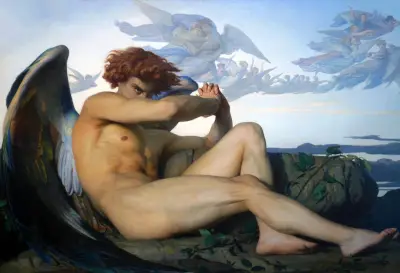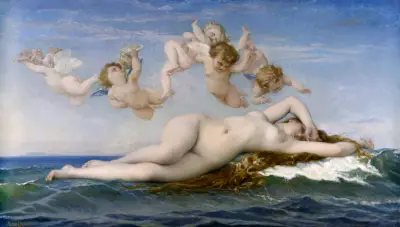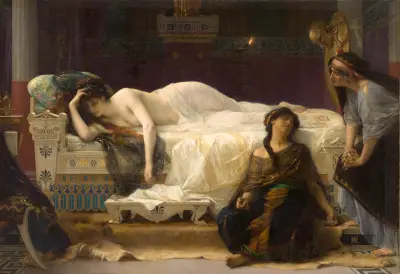Alexandre Cabanel's paintings provide some of the most impressive artworks to have come from French 19th century art. He specialised in the Academic Art movement and was particularly skilled as a figurative painter of mythological scenes and religious portraits.
Introduction
French art was a dominant force within the 19th century, with a number of talented artists appearing in a mixture of styles. On the more traditional side, you would find Alexandre Cabanel, who had trained in Paris at the prestigious École des Beaux-Arts, before becoming a professor there in later life.
Cabanel believed passionately in the Academic Art movement and believed it required the most rigorous of art education, just as he had received himself. He was introduced as a young student to classical mythology, religion and literature, and these would form the backbone of his content.
Some of his most famous paintings, such as Fallen Angel, The Birth of Venus and Phaedra provide examples of his typical artistic style, with attractive models lying in a variety of postures. His work was immediately accessible to all, even for those unfamiliar with mythological tales.
In later life the artist would teach many of his own students and pass the techniques of Academic Art on to the next generation. He was respected and loved by many of his pupils, who found him warm and approachable. He was also willing to embrace other artistic styles in the hope of broadening these young minds' outlooks.
Cabanel is a fine example of how the French art institutions worked during the 19th century, embracing creativity whilst ensuring that certain artistic values and techniques were learnt. Drawing was a fundamental part of this too, and Cabanel would have developed his talents as a draughtsman prior to working with oils.
Besides the paintings discussed here, Cabanel would also take on commissions in other disciplines as his reputation started to grow. A number of hotels would enlist him to re-develop their interiors, which proved a profitable niche for the artist, who initially worked as a collaboration before taking on projects by himself.
Academic Art would fall out of fashion after the rise of the Impressionists but artists such as Cabanel remain popular in the present day, where room can be found for all artistic styles from the past. The precise technical skills possessed within this group remains highly regarded and young students today can learn much from their approach.
This article examines the most famous paintings by artist Cabanel, and discusses the influences on his work. It is necessary to cover his artistic education, as well as the wider Academic art movement which held sway in France for a number of decades. We must also consider the significant donora within his career who helped to enable the artist to focus entirely on his work, without worrying about how he would profit from his art.
Table of Contents
- Introduction
- List of Alexandre Cabanel Paintings
- Artistic Influences
- As a Portrait Painter
- Evolution as an Artist
- Napoleon as a Patron
- Artistic Legacy
List of Alexandre Cabanel Paintings
Find below a list of famous Cabanel paintings, each of which features further detail within its own specific page. A browse of these artworks reveals a consistent style and content throughout, with stunning female figurative portraits dominating much of his oeuvre. Cabanel has not been as well documented as many other Academic artists, or indeed French painters from the 19th century more generally, and so there may well be other paintings out there will we have not included here.
Artistic Influences
Cabanet impressed as a young draughtsman and was transferred to an art school in Montpellier, before being awarded a place at the prestigious Ecole des Beaux-Arts in Paris. Here he would study under François-Edouard Picot, who was a prize-winning French painter who specialised in painting mythological, religious and historical subjects, just as Cabanet would later do.
When viewing some of Picot's better known works, such as L'Amour et Psyché and Léda, from the early 19th century, we can immediately see similarities with the style developed by his pupil. There are the undressed women, reclining in mythological settings. There were also a number of privately commissioned portraits, which would eventually come to Cabanet as well, once his reputation had grown sufficiently.
Picot had used inspiration from Jacques-Louis David, fused with his own elements of Romanticism and this style would be used by a number of his pupils. Picot also trained the likes of William-Adolphe Bouguereau, Gustave Moreau and Louis Émile Benassit.
The next phase of influence would come from Cabanet's time living in Italy, as part of his prize as runner up in the Prix de Rome competition. A scholarship would often only be awarded to the winner, so Alexandre was fortunate on this occasion and went out to make the most of his paid-for studies in Rome. Here he would study the classics, and also get a better understanding of Italian Renaissance paintings and sculptures.
The artist would also share a friendship with Alfred Bruyas, a painter and collector who shared Cabanet's interest in Italian antiquities and history. He demonstrated these Italian influences, and also eventually collected some of Alexandre's work for his growing collection. Having travelled extensively, and studied for a number of years both the techniques of art, but also the types of subjects that he might cover in his work, Cabanet would return to Paris and start to exhibit work at the Salon.
As a Portrait Painter
The artist supplemented his income with a large number of private commissions, typically of young women from French high society. These requests could be fitted in around other, larger projects, including his work on hotel interiors. Cabanet's prominent role within the French Salon brought him many opportunities and helped him to acquire a number of particularly wealthy patrons who were passionate about his work.
Catharine Lorillard Wolfe, Miss Cornelia Lyman Warren, Mary Victoria Leiter, Lady Curzon and Olivia Peyton Murray all appear within his oeuvre, and typically the artist would choose fairly traditional postures and settings for his models. These were skillful but pragmatic compositions, whilst his mythological pieces brought more invention into his work and provide many of his most respected artworks.
Evolution as an Artist
The artist's final years were remarkably open minded. He would attempt to refresh his oeuvre, perhaps inspired by some of his own pupils who had brought new ideas to his attention. Perhaps at this late stage he would realise that for all its qualities, the Academic art movement could sometimes appear to rigid in its methodology, and maybe the Impressionists, whom he had earlier rejected, had some value to add.
The 1880s would combine elements of Symbolism and Orientalism and Cabanel would also start to use slightly smaller canvases as he attempted to be bold through style rather than size. He may also have found it physically challenging to take on larger projects by this time and was content to experiment with some of the fashions of the time, realising that he had already taken Academic art styles about as far as they could go in the preceding decades.
Napoleon as a Patron
Emperor Napoleon III was an enthusiastic patron to Alexandre Cabanel, purchasing a number of his paintings. The Birth of Venus was exhibited at the Salon in 1863 and the monarch immediately was drawn to this stunning piece, purchasing it for himself. He employed the Marquis Philippe de Chennevieres to commission many more artworks from his preferred painters, and Cabanel was added to that list after impressing at the Salon for a number of years.
It is believed that his work on The Glorification of Saint Louis brought about an initial meeting with the emperor and this relationship grew significantly over time, with him evenually producing a direct portrait of Napoleon III in 1865. The mere connection to the monarch also encouraged many Parisien collectors to come onboard with the artist as well, ensuring that he was never short of sales from that point onwards.
Artistic Legacy
Alexandre Cabanet trained hundreds of artists whilst working as a professor at the Ecole des Beaux-Arts. A good number of these would go on to have successful careers of their own, with a number even receiving the prestigious Prix de Rome award. In serving on the Salon jury on a number of occasions, Cabanet was able to shape their success, and he attempted to be as open mided as possible with regards artistic style.
He became a highly regarded teacher, with many applications coming in for his services, with a number coming from abroad. He was also loved by his pupils, who found him warm and approachable, and encouraging in most cases. Édouard Debat-Ponsan, Henri Regnault, Fernand Pelez, Pascal Dagnan-Bouveret, Jules Bastien-Lepage and Jean-Eugène Buland provide good examples of the quality and variety of styles which developed after their experiences with Cabanet.







